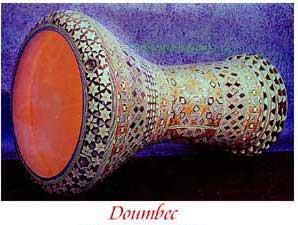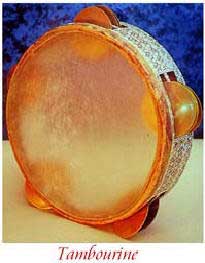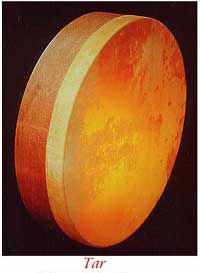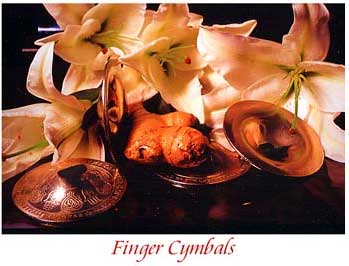|
Middle Eastern
Percussion Instruments
The
DAFF: A Mystical Instrument
by Mimi Spencer,
from the Near Eastern Music
Calendar, Vol II, #3,
April/May 1992
|
Doumbec /
Tambourine
/ Tar / Finger
Cymbals
Photos, Descriptions
& Historical Information
|
|
Doumbec
(also
known as darbuka, derbeki,
or tabla)
 Note:
The word doumbec is Armenian
and is used most often in the
United States among non-Middle
Eastern people. Darbuka,
derbeki and tabla are used
in Arab countries. Note:
The word doumbec is Armenian
and is used most often in the
United States among non-Middle
Eastern people. Darbuka,
derbeki and tabla are used
in Arab countries.
- The
doumbec is the most popular
drum in the Middle East.
It is goblet shaped with
a head stretched over
the bowl and can produce
an amazing variety of
bass (doum) and treble
(tekk) sounds by being
struck by the hands and
fingers. It is usually
played while being held
horizontally on the lap
or may be held by a shoulder
strap.
- Ceramic
doumbecs usually produce
a warm and earthy sound
and traditionally have
heads made of fish or
goat skin but synthetic
heads also are used.
- Egyptian
cast-aluminum doumbecs
are modeled after the
shape of the ceramic ones,
have mylar heads, and
are tune-able. They have
a very loud, crisp tekk
sound that is easily heard
over amplified instruments.
Other benefits are that
they don't break easily
and the mylar heads don't
change tone with changes
in temperature and humidity.
- Turkish
doumbecs are made of thinner
metal and have tune-able
heads. The edges of the
doumbec are sharper and
they produce a more ringing,
metallic tone. The shape
also is conducive to snapping
with the fingers. Some
Turkish doumbecs have
cymbals on the inside
which produce a ringing
accompaniment to the traditional
drum strokes.
- There
is some belief that the
doumbec was invented by
women potters many centuries
ago. "To store the
accumulation of grain
from farming, women developed
the art of ceramicscreating
cooking and storage vessels
of fired clay." (Redmond,
1997 p.44) It was only
a matter of time before
someone placed a skin
over a storage vessel
and created the ceramic
drum.
Top
|
|
Tambourine
(also
known as daff or riqq)
Note:
The word tambourine is used
in the United States most often
among non-Middle Eastern people.
Daff is used in most Arab countries
and riqq only in Egypt.
- The
tambourine is considered
a serious percussion instrument
in the Middle East.
It is held upright in
one hand and produces
three distinct sounds:
that of the skin
when struck in the center,
that of the wood
when struck close to the
wooden rim, and that of
the metal when
played more delicately
with the fingers striking
individual cymbals and
more raucously by shaking
the entire tambourine.
- Most
Egyptian tambourines are
wooden, traditionally
have a fish or goat skin
head, and have five sets
of cymbals. The most common
size of tambourine is
8 1/2 inches in diameter.
- Metal
Egyptian tambourines have
tune-able mylar heads
and five sets of cymbals.
Their sound is much louder
than wooden tambourines
enabling them to be heard
better when played with
heavily amplified instruments.
Other advantages of metal
tambourines with mylar
heads is that they don't
sag and lose their tone
in humid weather and they
don't break easily. Some
disadvantages are that
the metal tambourines
can be harsh in sound
and also are much heavier
than wooden tambourines.
- For
classical style tambourine
playing, the tambourine
is held in both hands
and the head is struck
with the fingers of both
hands without involving
the cymbals.
- Tambourines
were used for Dionysian
rites as early as 300
AD.
-
The
shape of the tambourine
is symbolic. "A traditional
Middle Eastern tambourine,
with five sets of moon-shaped
jingles representing the
five phases of the moon:
birth, growth, fruition,
dissolution,
and death." (Redmond
1997 p. 34)
- In
Egypt, tambourines were
used by women in religious
ritual. "During the
thousands of years the
tambourine is represented
in Egyptian history, it
is always in the hands
of acclaiming and rejoicing
women participating in
sacred dances and processions
or playing in front of
goddesses - Layne Redmond."
(Hart 1991 p.32)
- The
metallic sound of the
cymbals on the tambourine
has protective ability.
"The ringing of the
metal drove away harmful
spirits, enemies, or the
effects of the evil eye.
From the most ancient
times to the present day,
the shaking of jinglesthe
clash of cymbalshave
retained this shamanistic
function." (Redmond
1997 p. 99)
Top
|
|
Tar
(also
known as frame drum or duff)
Note:
The word tar is used in the
Sudan. Duff is used in
Arab countries.
- A
tar is a round wooden
frame drum whose diameter
is much bigger than its
depth. Goat skin traditionally
is stretched over the
frame to create the head
although synthetic versions
are now used. Some tars
have a thumbhole or indentation
in the frame to facilitate
holding.
- Tars
range from 10-22 inches
in diameter but the most
commonly used size is
16 inches.
- The
tar is held upright in
one hand and is struck
with the fingers of that
hand and the full hand
and fingers of the other
hand. The tar is known
for its deep, haunting
tones.
- The
bendir is a Moroccan frame
drum that has 2-3 gut
sinew snares across the
back of the goat skin
head. This produces a
buzzing vibration when
the head is struck.
- The
doira is a Persian frame
drum with a goat skin
head and ring-shaped jingles
attached to the back of
the frame. It jingles
when the head is struck.
- The
tar, being played by a
woman, first appeared
on a shrine room wall
in ancient Anatolia (modern
day Turkey) from
6000 BC.
- The
round frame tar first
appeared in Egypt c.1417-1379
BC.
- Tars
historically have had
a very important religious
significance. "Female
performance ensembles
of musician, singers,
and dancers appear in
some of the earliest representations
of religious rituals.
The frame drum was at
the musical and psychic
center of these rituals."
(Redmond, 1997 p.10)
- The
tar was used in religious
rituals of the Mother
Goddess. It is thought
to correspond to the pulse
of life, similar in sound
to the heartbeat we hear
in our mothers' wombs.
The tar also is representative
of the moon and fertility.
- It
is believed that the tar
was developed by women
who used grain sieves
to clean the grain. Their
shapes are the same. "Since
ancient times, the grain
sieve and the frame drum
have been thought to share
a common origin. One of
the oldest names for the
frame drum in the ancient
Sumerian language also
means grain sieve."
(Redmond, 1997 p.47)
Top
|
|
Finger
Cymbals
(also
known as sagat or zills)
 Note:
The word zills is used in
Turkey.
Sagat is used in Arab countries. Note:
The word zills is used in
Turkey.
Sagat is used in Arab countries.
- Finger
cymbals are round and
slightly bell shaped.
They are made of brass
and come in a variety
of shapes and sizes, each
with a different tone.
Finger cymbals are played
by both musicians and
dancers.
- Finger
cymbals are worn in pairs
on each hand, one attached
to the thumb at the first
knuckle and one attached
to the middle finger.
The cymbals are attached
by elastic drawn through
holes or slots in the
cymbals.
- Sounds
are produced by striking
the cymbals together,
either straight together
or one straight and one
on the edge. There are
three major tones: ringing,
clicking, and clacking.
- Dancers
with finger cymbals can
be found in ancient Egyptian
tomb paintings (1320-1200
BC) and were also used
in India, Turkey, and
Greece.
Top
|
|
 Note:
The word doumbec is Armenian
and is used most often in the
United States among non-Middle
Eastern people. Darbuka,
derbeki and tabla are used
in Arab countries.
Note:
The word doumbec is Armenian
and is used most often in the
United States among non-Middle
Eastern people. Darbuka,
derbeki and tabla are used
in Arab countries.

 Note:
The word zills is used in
Note:
The word zills is used in